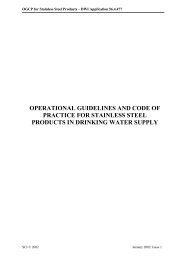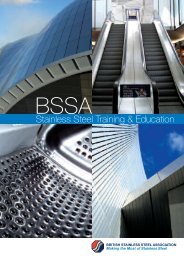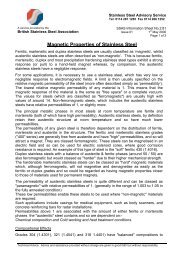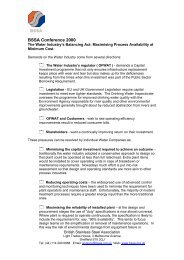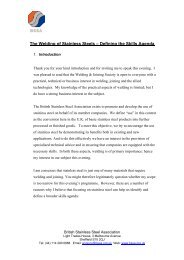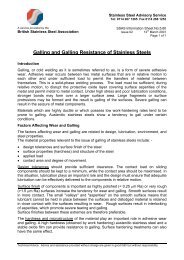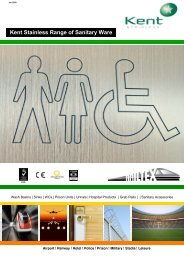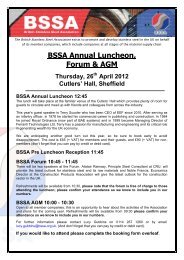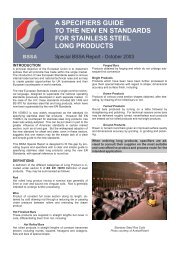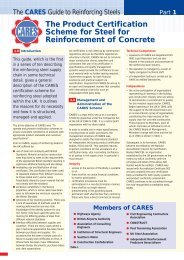Information Sheet No - British Stainless Steel Association
Information Sheet No - British Stainless Steel Association
Information Sheet No - British Stainless Steel Association
Create successful ePaper yourself
Turn your PDF publications into a flip-book with our unique Google optimized e-Paper software.
<strong>Stainless</strong> <strong>Steel</strong> Advisory Service<br />
Tel: 0114 267 1265 Fax 0114 266 1252<br />
A service provided by the<br />
SSAS <strong>Information</strong> <strong>Sheet</strong> <strong>No</strong>.5.01<br />
<strong>British</strong> <strong>Stainless</strong> <strong>Steel</strong> <strong>Association</strong> Issue 03 12 th March 2001<br />
Page 1 of 5<br />
Introduction<br />
Surface Finishes of <strong>Stainless</strong> <strong>Steel</strong><br />
Surface finishing treatments applied to stainless steels can take many forms. The main<br />
objective of these treatments is to restore optimum corrosion resistance following thermal<br />
and mechanical processing, and to enhance cosmetic appeal.<br />
The treatments in frequent use are:-<br />
• Acid treatment – of which descaling is the most common<br />
• Mechanical polishing, abrasive blasting and electropolishing<br />
• More specialist surface treatments such as colouring may also be applied<br />
Acid Treatments<br />
1. Pickling and Descaling<br />
Oxide scale resulting from heat treatment or welding can be removed by immersion in an<br />
acid solution containing diluted hydrofluoric acid. Hydrochloric acid based pickles, such as<br />
those employed for pickling carbon steels, should be avoided due to the risk of pitting<br />
corrosion. For items too large for immersion treatment, spray pickling processes can be<br />
used. For use on vertical or overhead surfaces or where the treatment needs to be<br />
localised, as on welds, pastes or gels, which can be applied with a brush, are beneficial.<br />
Exposure time will vary depending on thickness and type of scale, strength and<br />
temperature of the pickling product employed. Complete removal of oxide scale and other<br />
surface contaminants is essential for good corrosion performance. Thorough washing with<br />
water should follow all acid treatments.<br />
2. Passivation<br />
<strong>Stainless</strong> steel owes its corrosion resistance to a very thin oxide film on its surface. This<br />
passive film will form when a clean stainless steel surface comes into contact with oxygen<br />
in the air. This action can be accelerated by immersion in a dilute nitric or citric acid<br />
solution and this is referred to as passivating. Spray-on solutions and paste type products<br />
can also be used for passivating.<br />
Technical Advice: Advice and assistance provided without charge are given in good faith but without responsibility
SSAS <strong>Information</strong> <strong>Sheet</strong> <strong>No</strong>.5.01<br />
Issue 03 12 th March 2001<br />
Page 2 of 5<br />
Mechanical Polishing<br />
This method of surface treatment is generally carried out with the objective of creating an<br />
aesthetically pleasing cosmetic finish or a controlled surface roughness/brightness<br />
condition of specific applications. Where measured finishes are specified these will<br />
normally be as ‘Roughness’ (CLA) in microns Ra or Reflectivity in Gloss Units.<br />
Mechanically polished finishes can be applied to virtually all products before fabrication i.e.<br />
Plate, <strong>Sheet</strong>, Bar, Tube, etc and can subsequently be blended by conventional hand<br />
polishing after assembly or fabrication.<br />
Grinding/polishing operations are carried out using iron free abrasive belts or wheels of<br />
either Aluminium Oxide or Silicon Carbide construction. Buffing operations may be carried<br />
out using nylon web rolls/flapwheels or sisal mops whilst Bright/Mirror finishes would be<br />
produced on cotton mops using an appropriate compound.<br />
Consideration should always be given to operating conditions in service when specifying<br />
polished finishes as contamination may occur in certain circumstances should an inferior<br />
finish be used.<br />
Abrasive Blasting<br />
This process which can be carried out either wet or dry is an alternative to acid cleaning<br />
and descaling. It is important to use the correct iron free abrasive in order to avoid surface<br />
contamination. Any abrasives, which are re-circulated, should be cleaned to ensure they<br />
are free from contaminants. After treatment components should be thoroughly washed in<br />
clean water and dried.<br />
Barrel and Vibratory Finishing<br />
Both these treatments can be carried out on stainless steel parts. The precautions listed<br />
for abrasive blasting apply equally for these types of finishing operations.<br />
Electropolishing<br />
This well proven process electrochemically removes a fine surface layer, leaving a micro<br />
smooth, highly corrosion resistant, reflective surface with an excellent oxide film. The<br />
treatment can be employed for decorative and functional applications or for a combination<br />
of both. The ultimate finish will largely depend upon the surface condition prior to<br />
electropolishing. The process is also suitable for removing fine burrs from machined<br />
components and pressings.<br />
Technical Advice: Advice and assistance provided without charge are given in good faith but without responsibility
SSAS <strong>Information</strong> <strong>Sheet</strong> <strong>No</strong>.5.01<br />
Issue 03 12 th March 2001<br />
Page 3 of 5<br />
Special Finishes<br />
In addition to the methods described overleaf it is possible to achieve special effects on<br />
<strong>Stainless</strong> <strong>Steel</strong> by using any of the following techniques.<br />
Surface finishes as supplied on Flat Rolled Products.<br />
Finishes are specified in BSEN 10088:2 for flat products. This standard now replaces the<br />
obsolete BS1449:2 1983, which was withdrawn in 1999. The BSEN 10088:2 finishes follow<br />
the following convention and are shown in more detail on the table on page 4.<br />
Hot Rolled material will have the first digit ‘1’<br />
Cold Rolled material will have the first digit ‘2’<br />
Special finishes will take the first digit of the base material and should be specified as to<br />
whether required on one side or both sides.<br />
1. Electroplating<br />
Many different electro-deposits can be applied; to increase surface hardness, to improve<br />
lubrication, to avoid seizing, to enhance solderability and to minimise bi-metallic (contact)<br />
corrosion. Chromium, autocatalytic (electroless) nickel, silver, cadmium, nickel and tin<br />
plating can all be applied.<br />
2. Colouring<br />
Achieved by chemical surface treatment, which modifies the normal protective passive<br />
oxide film. An attractive range of colours can be produced which enhance the decorative<br />
appeal of <strong>Stainless</strong> <strong>Steel</strong>.<br />
3. Specialised Surface Treatments<br />
Bonded dry-film lubricants (molybdenum di-sulphide), ion implantation and PVD (physical<br />
vapour deposition) for wear resistance. Organic coatings – PTFE type resins for low<br />
friction, special electrophoretic lacquers for tinting purposes and metal spraying can also<br />
be supplied.<br />
4. Cosmetic Patterned Finishes<br />
There are a number of patterned finishes available, which are cold rolled onto the surface.<br />
These include linen, leather, letters and mosaic effects.<br />
Technical Advice: Advice and assistance provided without charge are given in good faith but without responsibility
SSAS <strong>Information</strong> <strong>Sheet</strong> <strong>No</strong>.5.01<br />
Issue 03 12 th March 2001<br />
Page 4 of 5<br />
European Standard<br />
Number EN 10088-2<br />
Surface Finishes Specified in BSEN 10088:2<br />
Redundant<br />
BS 1449-2<br />
Description<br />
<strong>No</strong>tes<br />
HOT ROLLED<br />
1U - Hot rolled <strong>No</strong> further treatment<br />
1C 0 Hot rolled Softened<br />
1E 1 Hot rolled Softened, Mechanically descaled<br />
1D 1 Hot rolled Softened, pickled<br />
COLD ROLLED<br />
2D 2D Cold rolled Heat treated, Pickled<br />
2B 2B Cold rolled Heat treated, Pickled, Skin passes<br />
on bright rolls<br />
2A 2A Cold rolled Bright Annealed<br />
2H - Cold rolled Work hardened<br />
SPECIAL FINISHES<br />
1G/2G 3A Ground Uniform finish usually obtained with<br />
80-100 grit size. Ra 2.5µm approx<br />
2J 3B Dull Buffed Uniform straight grain finish usually<br />
achieved on 180-220 grit. Ra<br />
1.25µm approx<br />
1J/2J 4 Dull Polish Unidirectional texture – not very<br />
reflective. Final polishing on 180-<br />
240 grit. Ra 0.6µm approx<br />
1K/2K 5 Satin Polish Clean cut surface to achieve<br />
adequate corrosion resistance for<br />
marine and external architectural<br />
applications. Ra
SSAS <strong>Information</strong> <strong>Sheet</strong> <strong>No</strong>.5.01<br />
Issue 03 12 th March 2001<br />
Page 5 of 5<br />
may meet the general description in the table. Specifiers need to be aware that the finish<br />
supplies meets their individual requirements.<br />
Mill Finishes<br />
<strong>Sheet</strong> and strip supplied with mill finishes (1U through 2H) may, unless otherwise agreed,<br />
be supplied with only one surface inspected to the required finish.<br />
In such instances the manufacturer should indicate the prime surface either by marking the<br />
material or the packaging or by some other agreed convention.<br />
Polished Finishes<br />
Other polished finishes (1G through 2P) may also be available.<br />
Before commencing any task ensure that you have received the appropriate health and<br />
safety literature from the supplier and fully understand it. If in doubt seek advice.<br />
Technical Advice: Advice and assistance provided without charge are given in good faith but without responsibility
SSAS <strong>Information</strong> <strong>Sheet</strong> <strong>No</strong>.5.01<br />
Issue 03 12 th March 2001<br />
Page 6 of 5<br />
This <strong>Information</strong> <strong>Sheet</strong> is an update of BSSA <strong>Information</strong> <strong>Sheet</strong> <strong>No</strong>.2<br />
Technical Advice: Advice and assistance provided without charge are given in good faith but without responsibility



